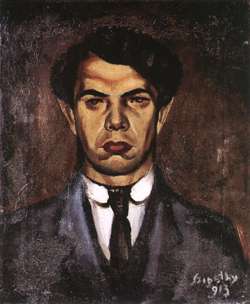BOHACSEK, Ede
(1889, Karánsebes - 1915, Budapest)


Ede Bohacsek was born at Karánsebes (today Caransebes, Romania) in September 1889. His father was Ede Bohacsek senior and his mother Anna Dávid. His father worked as a sculptor's assistant. In 1898 the family moved to Budapest where the artist spent the rest of his life.
We first meet his name in the 1903/4 school report of the Municipal Technical Drawing School. After 4 years of study at a secondary school he spent 10 months at the Technical Drawing School as a pupil in the" Public Drawing and Modelling Hall" whence he enrolled in the Royal Hungarian College of Applied Arts. Here he studied Interior Decoration for six months, only to try his hand the following year at the faculty of Ornamental Sculpture.
At the end of the first decade of the 20th century opportunities presented themselves for the young artist to exhibit his work to a wider public. In November 1910 his work was shown at the Winter Exhibition of the Művészház and at further shows at the same place.
But Ede Bohacsek contracted TB and fate him but few years to live. The first time the wider public had an opportunity to see his collected oeuvre was a few years after his death. In the catalogue of the first exhibition following his death there are 39 items. Divided according to subject matter these were 24 landscapes, 4 pictures depicting biblical subjects, 3 theatrical ones and 3 compositions. Four more works don't fit any of these categories. Of the landscapes nine have general subjects, two depict arable fields, bathing huts, church squares, wine cellars, grapes, country roads, houses, trees and cloud studies. Of the biblical ones one represents St. Anne and two the Virgin Mary. There are self-portraits and figurative compositions: pictures with theatrical subjects also belong to this category.
The works of Bohacsek show in addition to the signature also the place where he painted or drew them. We know from the drawings that he worked in Léva in 1910 and also visited other small towns like Trencsén, Podvilk (now in Slovakia). It is here that he painted most of his surviving works. Several of his drawings represent the countryside around Törökbálint (near to Budapest): the above are his main works and represent the major part of his legacy. The painter experimented with every technique. Frequently he painted the same picture in oils and also in pastels. However, sometimes the landscapes serve merely as a backdrop to figurative paintings. These two or three almost sexless figures are actors on a stage, with the landscape as background. They sit, leaning on their elbows, or they lie on the ground, sometimes there is a standing figure with a bowl of fruit in his hands. The figures are often biblical ones. Most of his biblical pictures show scenes from the life of the Virgin Mary, St. Anne and St. Anthony of Padua.
Several experts and art historians who studied Bohacsek's work classed him as an Activist: a colourful, striking practitioner of naive art. This is the reason why in the sixties his pictures were shown in exhibitions devoted to naive art. However there was another school of thought which did not consider him as belonging to the naive school but simply being in sympathy with that movement. We have to agree with those who see him as an innovator. Bohacsek's merit is that "at the time of the disintegration of Western academic spirit" he was able to point the way in a direction, unfettered by academic restrictions. He was the first one to follow the road first trod by Henri Rousseau and Marc Chagall and he was able to stay on this road on the borders of folk art and "grand art" because - like the cited artists - his works belong without exception to "grand art".
